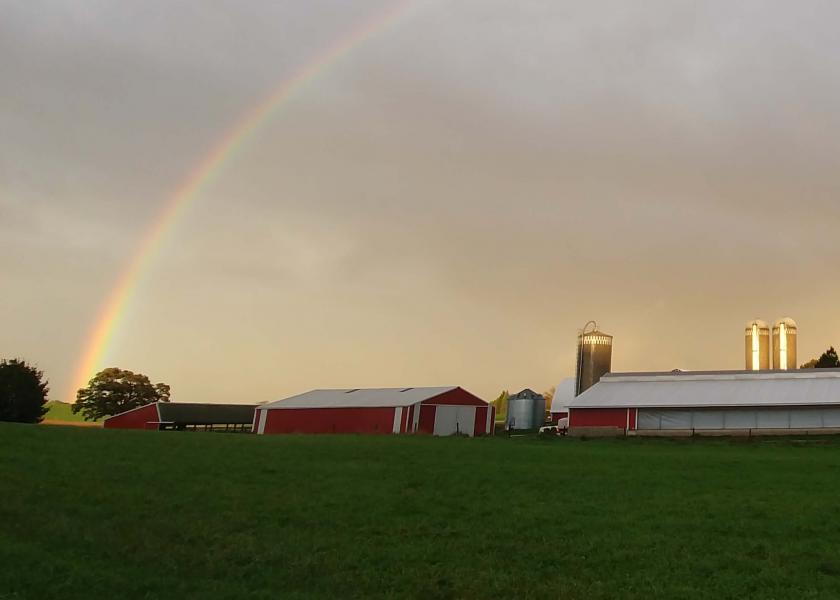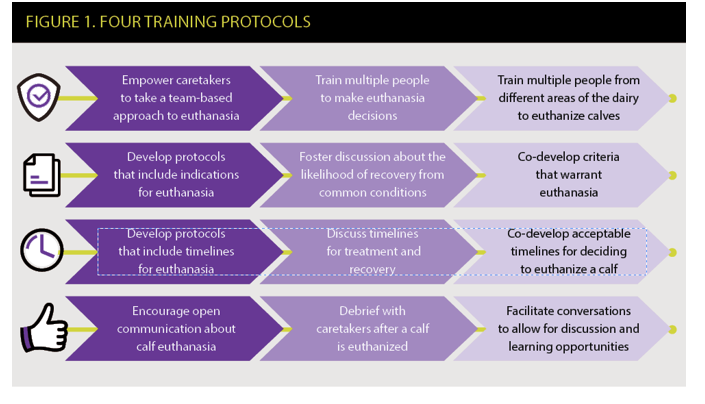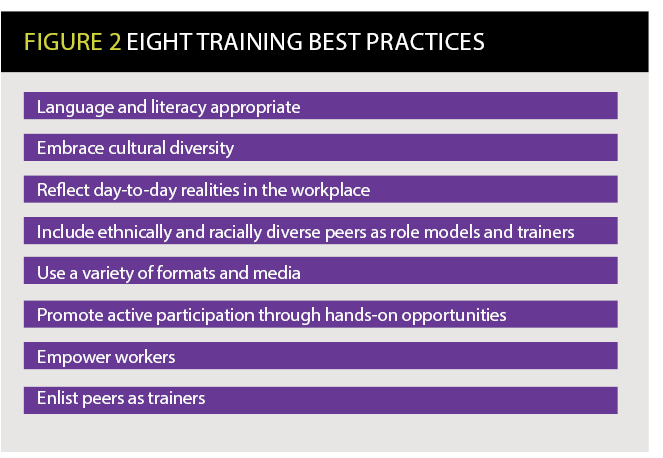When Sick Dairy Calves on the Farm are Unlikely to Recover

This article was written by Catie Cramer, MS, PhD, Assistant Professor, Department of Animal Sciences, Colorado State University.
Optimal calf health is key to raising productive and profitable animals and is a critical component of good animal welfare. The two most common diseases in preweaned dairy calves are gastrointestinal disease and respiratory disease. Decision-making for treating these diseases is complex. An essential part of the decision process for treating sick calves is euthanasia, which must be considered to minimize animal pain and suffering.
The National Animal Health Monitoring System of the USDA reports that of all the dairy calves that died in 2014, 93% were the result of unassisted death, meaning they were not euthanized (USDA, 2018). This is over 30% higher than in cows and means 93% of calves die “naturally,” during which they may experience severe pain (Shanan, 2015; USDA, 2018). Improving timely euthanasia for dairy calves is necessary to mitigate negative effects on calf welfare. Deciding to euthanize a calf, or any animal, is a difficult and complex decision involving many people with varying roles, along with animal welfare and financial considerations.
Although veterinarians have a key role in calf treatment, including euthanasia, it is the dairy caretakers – the workers on the farm caring for animals daily – that are responsible for detecting, treating and making euthanasia decisions for sick animals on about 80% of dairies (USDA, 2018; Wagner et al., 2020). Caretakers on dairies are often considered the “invisible stakeholder,” because they play a critical role in animal care but are often overlooked when considering the needs and perspectives of industry groups. Understanding caretakers’ perspectives of euthanasia is crucial to identify training needs and improve calf welfare.
Our research team, building on decades-long work with dairy caretakers by team member Dr. Noa Román-Muñiz, takes a multidisciplinary approach to tackling the complex topic of euthanasia with team member expertise in agricultural worker health and safety, animal welfare, calf health, epidemiology, and veterinary medicine. To better understand the challenges faced by caretakers when making calf euthanasia decisions, we conducted focus groups and interviews with 38 dairy caretakers on five dairies in the western U.S. These findings were published in 2021 in the journal “Animals” (Román-Muñiz et al., 2021).
Here, we summarize our findings specific to calves, with some unpublished quotes from study participants, that highlight the training needs of caretakers that veterinarians would be uniquely suited to address.
Caretakers feel a strong bond with calves, which makes euthanizing calves more difficult than cows.
Across all dairies, roles, and experience levels, the human-animal bond was apparent between caretakers and the calves under their care. Characteristics unique to calves, perhaps their age, appearance, or the time and way employees must care for calves, make euthanasia decisions extremely challenging for caretakers. For example, one participant remarked, “I personally dislike putting down baby calves. I find that a little distressing ... . Baby calves are the coolest part of the farm. They’re full of hope and they’re cute and they’re having fun. So if you were to ask me ... that’s what I dislike the most. It’s always for a good reason, but it is part of the job, and it’s not a pleasant part.”
The strong human-animal bond was inextricably linked to comments about calf welfare.
Euthanasia was often seen as a “kindness” for cattle that were in pain, and caretakers shared that their feelings towards an animal could affect how they feel about euthanizing an animal, especially calves. One owner-operator remarked, “I don’t think anyone likes to put down a cow or an animal but sometimes knowing that’s what’s best is what gets them through. But there have been times where we have pets, or the guys develop a relationship, or they know that calf and they can’t. They are just like ‘I can’t do it.’ Even if it is better for the animal. And then I’ll have to talk about it and someone will have to decide ‘OK, we can do it,’ or I can.”
Despite knowing that euthanasia was necessary to prevent calf suffering, the strong human-animal bond sometimes precluded a caretaker from performing euthanasia.
One dairy addressed this by having a person not involved with calf care perform euthanasia, because asking a person to perform euthanasia on a calf that they felt a strong bond with would be “horrible.”
Euthanasia decision-making for calves was sometimes prolonged due to a desire for the calf to recover, and euthanasia was sometimes seen as a failure. For example, one owner operator shared: “Those people are with those animals every hour of the day that they’re here and really work hard and really, really love those calves. And so when I show up with my rifle, there’s been times when I’ve been told not to do that and I’ll look at the animal and if I think that it’s not suffering, I’ll say ‘OK you can try a little bit more.’ But I do explain to them, ‘this baby calf is never going to be a cow, she’s ill.’”
When asked if they gave more opportunity for cows or calves to recover, one caretaker shared “probably calves, usually just because they can rebound a lot quicker. Cows, like we were saying before, once you hit 12 hours, they aren’t coming back...and calves we’ve had some that have been down for four to five days and you just keep (giving) electrolytes and IV fluids and they somehow come out of it. So I’m always willing to go a lot further with calves than with cows.” One manager said that he did not find the process of euthanizing calves distressful, rather “... Usually I’m just more frustrated because it’s like “how did you get to that point?.’”
How can veterinarians help develop training programs and protocols for calf euthanasia?

Training programs should be culturally responsive to ensure they are effective. Over half of U.S. dairies have workers who are foreign-born and native Spanish speakers (Ribiera et al., 2020).
Best practices for culturally responsive training programs for this population have been previously described (Menger et al, 2016) and include the eight outlined in Figure 2.

For questions, please contact Dr. Catie Cramer at catie.cramer@colostate.edu.
References:
Menger, L.M., J. Rosecrance, L. Stallones, I.N. Roman-Muniz, 2016. A guide to the design of occupational safety and health training for immigrant, Latino/a dairy workers. Frontiers in public health, 4, p.282.
Ribiera L., F. Adcock, D. Andersen, 2020. A National Survey of Hiring, Compensation and Employee Treatment Practices on U.S. Dairy Farms. In: Studies CfNA, editor: Texas A&M.
Román-Muñiz, I.N., M.C. Cramer, L.N. Edwards-Callaway, L. Stallones, E. Kim, S. Thompson, H. Simpson, S. Mijares, 2021. Dairy caretaker perspectives on performing euthanasia as an essential component of their job. Animals 11(2), p.289.
Shanan A., 2015. Pain management for end of life care. Pain Management for Veterinary Technicians and Nurses, p331-339.
USDA. Health and Management Practices on U.S. Dairy Operations, 2014. Fort Collins, CO: USDA–APHIS–VS–CEAH–NAHMS, 2018.
Wagner, B.K., M.C. Cramer, H.N. Fowler, H.L. Varnel A.M., Dietsch, K.L. Proudfoot, J. Shearer, M. Correa, M.D. Pairis-Garcia, 2020. Determination of dairy cattle euthanasia criteria and analysis of barriers to humane euthanasia in the United States: Dairy producer surveys and focus groups. Animals, 10(5), p. 770.







